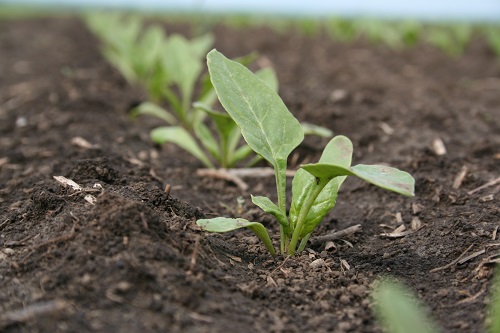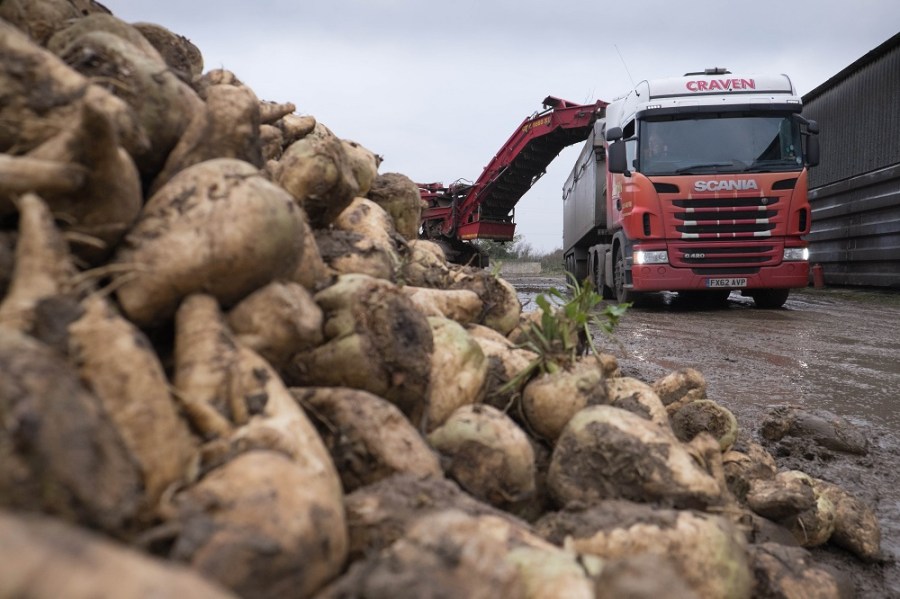There’s something for everyone on the new sugar beet RL for 2018. CPM takes a look at what the newcomers have to offer.
Choosing a new sugar beet variety is no longer just about output.
By Lucy de la Pasture
Six new varieties of sugar beet have made it on to the Recommended List for 2018, managed by BBRO (British Beet Research Organisation) and BSPB (British Society of Plant Breeders). The new varieties added are Bloodhound, BTS 3325, Daphna, Degas, Landon and Senada KWS, providing genetic lines from three different plant breeders.
This year’s RL marks a change in the way varieties are assessed. To make the grade, successful varieties must demonstrate significantly better performance, not just for yield but also for resilience to disease and bolting risk. Bram van der Have, sugar beet consultant for Limagrain, welcomes the change.

Landon is a high sugar variety with excellent establishment and is ideal for later drilling.
“Choosing a new sugar beet variety is no longer just about output. Agronomic characteristics, such as bolting tolerance and disease resistance, are becoming increasingly important characteristics to consider, which is why the RL now requires varieties to perform well in these categories over three years of field trials,” he says.
Tough process
Mike May, chair of the RL Board, explains that the selection process is tough. “We’re testing the genetics, which means the conditions need to be as uniform as possible across the plots for both the newcomers and the controls. The sites are on farms run by some of our best growers so we can see how the varieties perform under field conditions.”
To be eligible for consideration for the RL, varieties must be on the National List which is overseen by APHA, or the EU Common Catalogue by 1 March of the year before. To be considered for the RL, the new variety must bring distinct characteristics, be uniform and stable in performance and offer value for cultivation and use. If it has a special trait, such as partial resistance to AYPR rhizomania, then it might make the grade even if the yield is not significantly better.

Mike May explains that selection for the RL is a tough process.
The Trials Technical Group, currently chaired by Daniel Godsmark of the BBRO, oversees the technical aspects of the trials, and the results are analysed by NIAB before being presented to a multi-stakeholder Crop Committee to make the final decision. This year all the data has been presented in a new format, but one that’s already familiar to the industry to help interpretation of the results.
Dr Simon Bowen, Knowledge Exchange and Crop Progression Lead of BBRO, is particularly interested in how the varieties perform in bolter trials. A cold period will bring on vernalisation (the production of flowers) which is undesirable, as the plant will produce seed instead of building sugar in the root.
“A long growing season will improve the yield and sugar concentration, but an early sowing increases the risk of bolting. The trials include a comparison between Early Sown Bolting (ESB) and Normal Sown Bolting (NSB) to see how a variety performs under severe conditions. The results mean that growers will be able to make an informed decision about the risk of bolting,” he explains.
Of the newcomers, Bloodhound offers growers an opportunity to sow early and maximise yield potential with the lowest bolting score on the RL.
The list assesses early sowing by counting bolters/ha in plots sown before March 5. The average of all control varieties was 6745/ha but Bloodhound scored 2882/ha demonstrating its impressive resistance to bolting, explains SESVanderHave UK director, Ian Munnery.
“Early drilling is the key to making the most of the yield potential of sugar beet but it also carries the risk of early bolting, which will reduce yields and increase costs.”
At the other end of the spectrum is Landon, from sugar beet breeder Strube. It’s a high sugar variety with excellent establishment which is ideal for later drilling, highlights Richard Powell, UK managing director of Strube.
Recognising the need for genetic diversity in varieties, Strube have produced another of the RL debutantes, Degas, with an entirely different set of characteristics. It’s is a low-bolting variety, suitable for earlier drilling, and combines improved sugar content with vigorous growth for rapid ground cover.
Richard Powell stresses the need to consider genetic diversity when devising planting plans for sugar beet.
“This is already a recognised in UK practice, where no single variety is allowed to take more than 20% of the market. But ten of the twelve highest yielding varieties are derived from a similar genetic background. In the interests of managing risk, it does make sense to choose varieties from different breeders,” he comments.
Growers no longer need to sacrifice yield when selecting for nematode tolerance and disease resistance, with new varieties from KWS combining high yields with robust performance against pest and disease pressures, claims Ben Bishop, UK country manager for sugar beet at KWS.
Daphna is the first BCN-tolerant variety to top the RL, with a yield of 106.9% of controls while Senada KWS is the second-highest yielding variety on the RL with a yield of 105.6% of controls.
“Daphna outperformed all varieties in trials over three contrasting seasons. Almost 7% higher yielding than the control varieties, it has the potential to improve enterprise gross margins,” reckons Ben Bishop.
“A low bolter count in the early sown window, and with good resistance to both rust (7) and powdery mildew (6), Daphna is suited to all farm situations and locations. It should also prove popular with growers as a means of controlling BCN infestations,” he adds.
“Senada KWS has the best combined resistance to powdery mildew and rust of any recommended variety, which combined with its high yield capability make it an impressive all-round performer. Delivering its best performances when sown from mid-March, the variety will appeal to growers wanting a range of varieties to spread the drilling workload,” he believes.
Disease resistance is also important and some of the new varieties have claims by the breeder that they are tolerant to BCN. However, the mechanism behind this is not known, points out Dr Mark Stevens, Scientific & Crop Stability Lead at BBRO, who goes on to explain how foliar disease resistance is assessed.
“Disease resistance to rust and powdery mildew is given a score based on percentage leaf infection. We have recently started conducting powdery mildew trials under controlled conditions to provide a reliable assessment of the plant’s resistance regardless of the disease risk for that season.
New from Limagrain, BTS 3325 has ticked the boxes when it comes to disease resistance, achieving a rust resistance rating of 7, a powdery mildew resistance rating of 5 and the added bonus of good resistance to downy mildew, says Bram van der Have.
He describes BTS 3325 as a high yielding, rhizomania-tolerant variety offering very high sugar content of 18.1%, which is one of the highest on the RL, making it a very attractive proposition for growers and end-users alike.
“But what makes BTS 3325 so exciting is that alongside this higher output, it’s also demonstrated a very low early-sown bolting score –one of the lowest on the RL in this slot. It’s likely to appeal to growers who are in the position to drill on or before 5 March, so it’s the ideal variety choice to start the beet-sowing period, but it’s also flexible enough to be sown later, without compromising its high yield and sugar content,” he explains.
Colin MacEwan, head of BBRO, commenting on the evolution of the RL programme, says that improving the quality and consistency of the RL programme will continue to drive yield.
“Having a strong list of varieties with background on how they perform year after year in the field will give growers the information they need to select the best varieties for their conditions. It’ll also be possible for them to benchmark their yields against crops grown under best practice,” he concludes.
Summary Characteristics of new varieties on 2018 RL


50 shades of grey with sugar beet varieties
Interpreting the data in the BBRO/BSPB Recommended List can be a challenge. Sesvanderhave’s director, Ian Munnery, attempts to clarify the 50 shades of grey into something more black and white.
With the end of the EU’s sugar regime, UK sugar producers are in a prime position to benefit from the opportunities in the sugar market. That means growers will need to fully utilise domestic processing capabilities by maximising their output. Variety selection is critical, both for yield and for early sown bolting resistance, so growers can take advantage of the length of the UK growing season by drilling sugar beet crops early, he says.
“Our maritime climate allows for an extended, more efficient campaign. Sowing in early March typically delivers around 10% more yield than April sowing. Our sugar beet growers also have efficiency on their side with larger field sizes, up-to-date machinery and professional management putting them in a good position to compete with European sugar exports,” he adds.
Already one interesting development has come to light, with an initial approach from Al Khaleej Sugar International to council planners for a massive new sugar factory in Harrogate, Yorks.
“This development helps underpin the positive outlook for the sugar sector. A new facility would provide an opportunity for northern growers to return to the crop” he comments.
The reason for this long-term optimism is because sugar beet bucks the global trend by delivering a year-on-year increase in yield, and so is an attractive crop to include within the rotation and for continued breeding innovation. But there are a number of things growers need to be aware of when considering selecting varieties, warns Ian Munnery.
“The provenance of the seed used in trials is something that shouldn’t be overlooked when looking at the RL data,” he explains.
New varieties first enter the list as provisionally recommended (Pr1), progressing to Pr2 in their second year and Pr3 in the third before becoming fully recommended (R) thereafter. Several varieties never progress to attain full recommendation, and this is why some varieties arrive on the RL with aplomb and then disappear quietly and quickly, explains Ian Munnery.
“The first three year’s results for a Pr1 variety are based exclusively on a 1kg sample of breeder’s seed. Only the data from Pr2 year onwards are from larger commercial bulks over 500 units and corresponds to the seed that’s sown on farm.
“Often there’s a dilution effect when early generation breeder’s material is bulked up, so Pr1 yield figures need to be regarded as offering potential, but also treat them with some caution until fully proven,” he explains.
He’s quick to point out that growers should try new RL varieties on the farm because of the potential they’ve shown to gain provisional recommendation, but suggests it’s sensible not to put all their eggs in one basket.
“At the end of the day, growing sugar beet is all about minimising risk and maximising yield. For that reason, selecting a variety with high bolting resistance should be a key consideration and this year’s list highlights the differences between them.
“The same goes for paying a high premium for traits you may want but don’t need. If you’ve had a problem with Beet Cyst Nematode you’d know about it, and with 95% of the UK market continuing to sow standard rhizomania varieties without any impact on yields, the scale of the issue needs to be kept in context, particularly as all the data from the RL is in the absence of the pest,” he points out.




